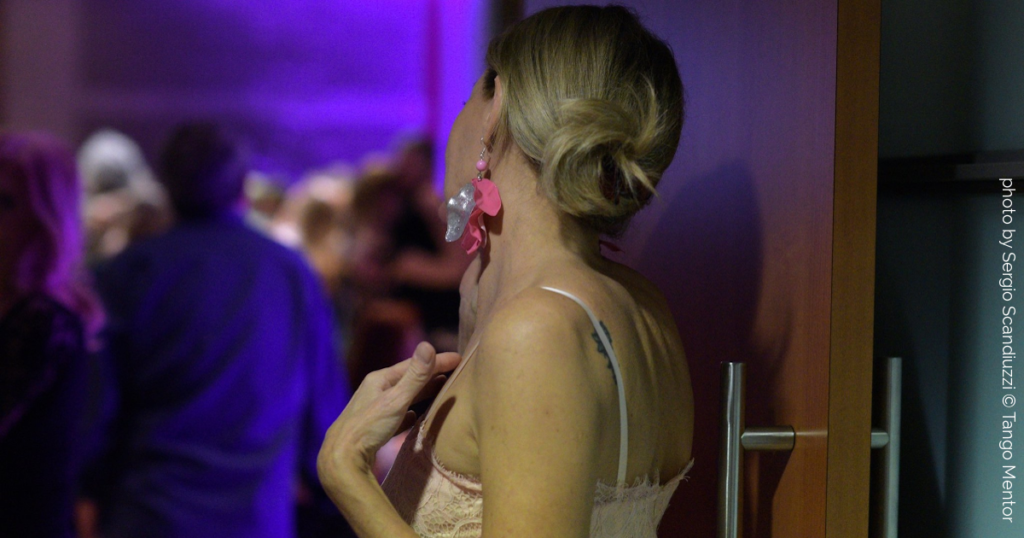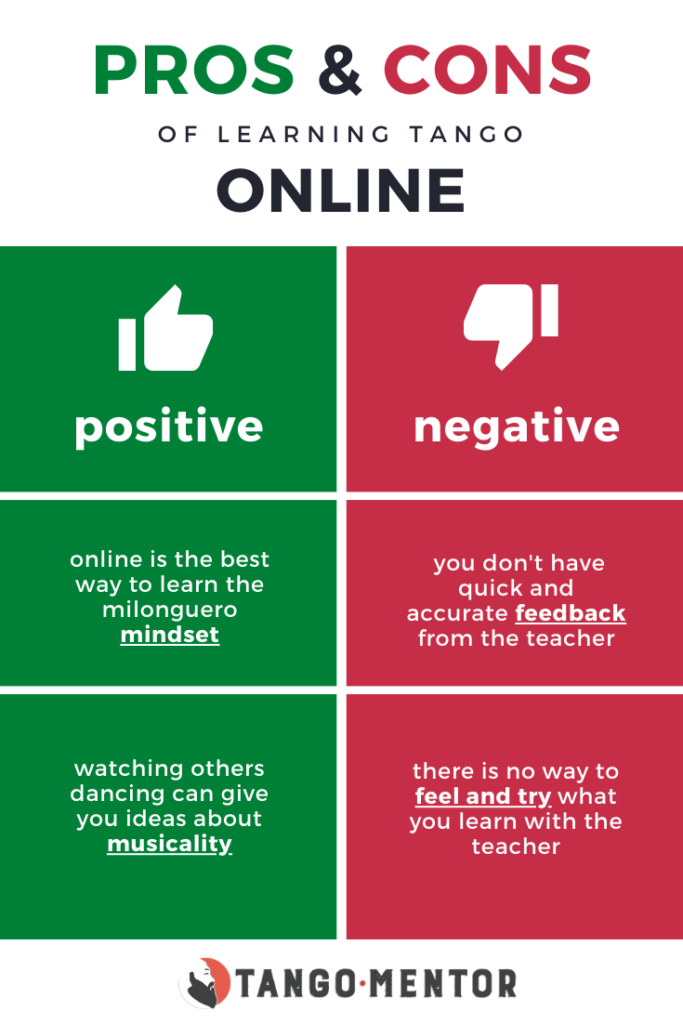
Learning tango online is considered a substitution for real workshops this year, but does it work? What is it good for and what are the drawbacks of learning online? What is online learning good for and where it fails to deliver?
For years, I’ve been working online with dozens of students and most of the time it worked well, but I’ve always guided my online students that learning online doesn’t work if you don’t have option to dance with someone who knows how it’s done.
Pros
- Online is a great way to learn the milonguero mindset
- Watching gives you ideas about musicality
Cons
- You don’t have quick and accurate feedback from the teacher
- You can’t learn by trying with the teacher
“I want to dance like those guys with more than 50 experience, those who danced in the Golden Age”, I told her with naive curiosity.
“But you already do!”, she answered.
Can you imagine how happy I was to hear this answer? She was experienced and well respected teacher and dancer from Argentina. We meet and danced by accident at a local milonga in Italy and after that I asked her for private classes.
This is her, dancing with Chiche Ruberto, who started dancing when he was seven and was dancing during the Golden Age of tango.
Well, to be honest, I don’t agree. I have to learn a lot to get to their level, but what happened then for me was confirmation that I’m on the right track.
How come I could get there if I never ever visited Buenos Aires?
[Tweet “Deep human experiences require human beings to be in a room with us.”]
Well, I was lucky enough that when my tango journey started there were no schools or teachers in my community. All we could learn was what more experienced dancers could show us on practicas (btw, the most experienced dancer back then had no more than 3 years in his sack).
I seriously wanted to become good dancer, so I tried to find better solution. My plan had two major components: first, to learn all I can online and, second, to take private classes with all experienced dancers that visited my town.
So, I learned online. A lot! But, I also took private classes. I can say that my learning process was combination of online and direct learning, plus a lot of practice with trial and errors.
Years after that, when I’ve got some dancing and teaching experience, I started my project Tango Mentor. My intention was to share my knowledge with the lonely learners like I was. I helped hundreds of students with my courses, my direct mentoring program and my workshops.
What I learned on that journey is that there are certain things that you can only learn online and others, that can never be learn on internet.
Pros
1. Mindset
There is much more to tango than just executing learned sequences and do them with the music. Unfortunately, many are focused too much on the sequences and music part without trying to understand the deeper meaning of what they do.
Of course, you can listen to Debussy or hang Picaso on your wall without knowing the context and the stories behind their art; you can even genuinely enjoy, but the real meaning comes to light when you have a little deeper understanding of what is going on.
It’s the same with the tango. Behind everything we do in tango there is a story which gives it meaning. Every step and ritual, every beat and melody, every idea and movement came from something and from somewhere. They were not invented by some brilliant maestro – they were crafted by generations of social dancers.
When I say this I don’t suggest that dancers should be robots without personality, contrary: I say that they should cultivate their personality in their dance with understanding what they do. The tradition is not a burden – it is something which can enrich your dancing and make you better in whatever is your way of dancing.
I know this because it worked for me and for my students. This is why I consider that the most important thing you can and you should learn is the mindset.
You can find tons of sources all around the internet, but I highly recommend you Tango and chaos in Buenos Aires. I also recommend you to sign up to my mailing list, since I regularly share interesting sources with my subscribers.
2. Musicality
I have this feeling that watching dances is neglected part of the learning process. Either teachers themselves dance show tango and their students try to use the stuff meant to be danced on stage when they are on the dance floor; or they leave their students to discover by themselves what they like from the wide variety of videos on internet.
Like that, we end up with students who can’t make difference between good and bad dancing, or between what is and what is not appropriate at the crowded dance floor.
My point is this: musicality gives you ideas about how to interpret the music. It’s illusion that you express your personality via your repertoire – 90% of what you do is usually developed by imitating the dancers you admire. If your idol is interpreting some tango in one way, you will most probably try to interpret it in the similar manner.
This is why, teachers should give their students recommendations, and that is especially important for the beginners, since their picture of what good tango is is usually shaped by some cheap Hollywood show dancing or acrobatics seen on a festival.
I would also here recommend Tango and chaos, but you can check the Cachirulo channel as well – specially the older videos with the old milongueros.

Cons
Our civilization invented magical technological tools to connect us and we should cherrish this fact, but expecting the technology to be substitute for real life interaction is an illusion. Not long ago I asked the huggers subscribed to my emails what they think about online learning, and, no surprise, most of them were skeptical.
The most common answers why they are skeptical about online learning tango were 1) that online the feedback is limited (if there is at all) and 2) that you can’t feel what the teacher teaches.
1. Limited feedback
When we talk about videos, CD-s and video courses, there is no immediate feedback at all. And I agree: recording yourself and waiting for a few days your teacher to see the video and give you feedback kinda sucks. We want feedback now and here, at the moment when we practice.
Many teachers during the Covid pandemic tried to use video tools like Zoom or Skype to teach online, which gives an option for the teacher to give immediate feedback, but it’s very limited. Teachers and students, both, are trying hard to make it work, but from the feedback I have, most of the time it simply doesn’t.
Why?
First of all, no matter how fast is your internet bandwidth, nothing can beat the real life presence. When working via two dimensional screen teacher can’t see all the angles and details of what their students are doing, and students can’t see all the subtle details that their teacher is trying to show them.
Second, some of the most important things in tango are not visible. The amount of pressure, the subtle direction of leading, the little reactions of the torso and hips when following – might often seem quite OK on video, but teacher can notice them 100% if he or she tries to dance with the student.
No online lesson can offer that kind of feedback.
2. You can’t feel what’s all about
For me, tango is about feeling – it has nothing to do with seeing or being seen. This is why during this lockdown I refused to take part in any so called online milongas. I simply don’t want to support the activities that try to support the normalization of something that should not be normal.
Person to person real life communication cannot be substituted with online presence… an argument comes to my mind, made by Simon Sinek when he was talking about bloggers conference.
Technology is wonderful for making connections. Technology is wonderful for the exchange of information. Technology is amazing for driving transactions: you can perform transactions faster than we’ve ever performed. But, technology is terrible for creating human relationships.
There was a time when a desktop meant something horizontal, today it means something vertical. And a folder, a picture, were the things we used to use. Now, that’s a fun example, but technology has co-opted some very human things as well. A friend is not somebody you check their status, your network doesn’t happen on LinkedIn, a dialog doesn’t happen on Twitter and a conversation doesn’t happen on a blog; those are human experiences and they require human beings to be in a room. Even blogers… I love how they talk about internet being the be-all and end-all of the world and yet every year, they come together, 20.000 of them, descend on Las Vegas, to have a conference. Why couldn’t they do it online? It’s because you have to have the human union.
– Simon Sinek
But, it goes even deeper!
I used to think that tango students are either in the group that learns by watching or in the group that learns by trying it out. Well, years of experience showed me that there are no students who learn by watching: there just those who can imitate better. The real learning happens only when someone tries that out with their teacher or with someone who does it right. The real revelation comes when you “feel” and not when you “understand” the point. That is the moment when the “a-ha” moment happens.
And, you can never have that online.
So, what is your experience? Does it match what I feel about it?

Leave a Reply